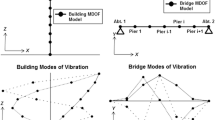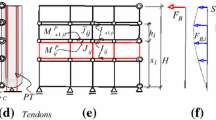Abstract
Rocking wall structures present a resilient alternative to conventional structures. Although the displacement responses of these structures have been discussed in past works, the force-based responses especially in the context of nonlinearity due to gap-opening behavior need to be explored in detail. In the current research, the effect of gap-opening behavior at predetermined locations in the rocking walls on the seismic force responses has been discussed. For this purpose, five rocking walls of varying heights and against two levels of seismic intensity are designed and analyzed using time history analysis procedure. A modal decomposition technique is used to separate the complex responses to their modal responses to better understand the different factors in play. It is found that the modal properties based on initial stiffness properties are unable to predict the inelastic seismic demands and a new capacity design procedure, based on modified modal properties incorporating the effect of gap-opening, has been proposed. The issues associated with the use of modified modal properties are discussed in detail and a simple, yet effective solution is shown to provide a much better prediction of inelastic seismic responses of these structures.
















Similar content being viewed by others
Data availability
The datasets generated during and/or analysed during the current study are available from the corresponding author on reasonable request.
References
Aragaw LF, Calvi PM (2020) Comparing the performance of traditional shear-wall and rocking shear-wall structures designed using the direct-displacement based design approach. Bull Earthq Eng 18:1345–1369
Blakeley RWG, Cooney RC, Megget LM (1975) Seismic shear loading at flexural capacity in cantilever wall structures. Bull New Zeal Natl Soc Earthq Eng 8:278–290
Buddika HADS, Wijeyewickrema AC (2018) Seismic shear forces in post-tensioned hybrid precast concrete walls. J Struct Eng 144:4018086
Carr A (2004) RUAUMOKO, manuals,“vol. 1 theory and user guide to associated programs, vol. 3 user manual for the 3-dimensional version.” Univ Canterbury, New Zeal
Chen X, Guan Z, Spencer BF Jr, Li J (2018) A simplified procedure for estimating nonlinear seismic demand of tall piers. Eng Struct 174:778–791
Chopra AK, Goel RK (2002) A modal pushover analysis procedure for estimating seismic demands for buildings. Earthq Eng Struct Dyn 31:561–582
Kovacs MA, Wiebe L (2019) Controlled rocking CLT walls for buildings in regions of moderate seismicity: design procedure and numerical collapse assessment. J Earthq Eng 23:750–770
Lin J-L (2019) Approximate quantification of higher-mode effects on seismic demands of buildings. Int J Struct Stab Dyn 19:1950023
Martin A, Deierlein GG, Ma X (2019) Capacity design procedure for rocking braced frames using modified modal superposition method. J Struct Eng 145:4019041
Munir A, Warnitchai P (2012) The cause of unproportionately large higher mode contributions in the inelastic seismic responses of high-rise core-wall buildings. Earthq Eng Struct Dyn 41:2195–2214
Pennucci D, Calvi GM, Sullivan TJ (2009) Displacement-based design of precast walls with additional dampers. J Earthq Eng 13:40–65
Petrini L, Maggi C, Priestley MJN, Calvi GM (2008) Experimental verification of viscous damping modeling for inelastic time history analyzes. J Earthq Eng 12:125–145
Priestley MJN, Amaris AD (2002) Dynamic amplification of seismic moments and shear forces in cantilever walls. IUSS Press, Pavia
Priestley MJN, Calvi GM, Kowalsky MJ (2007) Displacement-based seismic design of structures. IUSS, Pavia
Qureshi MI, Warnitchai P (2017) Reduction of inelastic seismic demands in a mid-rise rocking wall structure designed using the displacement-based design procedure. Struct Des Tall Spec Build 26:e1307
Qureshi IM, Warnitchai P (2016) Computer modeling of dynamic behavior of rocking wall structures including the impact-related effects. Adv Struct Eng 19:1245–1261
Rahgozar N, Rahgozar N (2021) Proposal of lateral forces for capacity design of controlled rocking steel cores considering higher mode effects. Structures 30:1086–1096
Rahgozar N, Moghadam AS, Aziminejad A (2018) Cantilever beam analogy for modal analysis of rocking core-moment frames. Bull Earthq Eng 16:4081–4106
Rahgozar N, Rahgozar N (2020) Extension of direct displacement-based design for quantifying higher mode effects on controlled rocking steel cores. Struct Des Tall Spec Build 29:e1800
Rahman MA, Sritharan S (2006) An evaluation of force-based design vs. direct displacement-based design of jointed precast post-tensioned wall systems. Earthq Eng Eng Vib 5:285–296
Rutenberg A (2013) Seismic shear forces on RC walls: review and bibliography. Bull Earthq Eng 11:1727–1751
Schoettler MJ, Belleri A, Dichuan Z et al (2009) Preliminary results of the shake-table testing for the development of a diaphragm seismic design methodology. PCI J 54:100–124
Smith B, Kurama Y (2012) Seismic design guidelines for special hybrid precast concrete shear walls. Struct Eng Res Rep NDSE-2012–02, Dep Civ Eng Geol Sci Univ Notre Dame, Notre Dame, IN http//hybridwalls nd edu/Project/Downloads/Design_Guidelines pdf
Steele TC, Wiebe LDA (2016) Dynamic and equivalent static procedures for capacity design of controlled rocking steel braced frames. Earthq Eng Struct Dyn 45:2349–2369
Sullivan TJ, Priestley MJN, Calvi GM (2008) Estimating the higher-mode response of ductile structures. J Earthq Eng 12:456–472
Wiebe L, Christopoulos C (2015) A cantilever beam analogy for quantifying higher mode effects in multistorey buildings. Earthq Eng Struct Dyn 44:1697–1716
Funding
The authors declare that no funds, grants, or other support were received during the preparation of this manuscript.
Author information
Authors and Affiliations
Corresponding author
Ethics declarations
Conflict of interest
The authors have no relevant financial or non-financial interests to disclose.
Additional information
Publisher's Note
Springer Nature remains neutral with regard to jurisdictional claims in published maps and institutional affiliations.
Appendices
Appendix A: DDBD procedure
Starting point of DDBD procedure is to convert a MDOF structure to an equivalent SDOF structure. Properties of this substitute structure and the overall design procedure is as follows: (Pennucci et al. 2009; Qureshi and Warnitchai 2017).
Design displacement of equivalent structure (\({\Delta }_{d}\))
where \({m}_{k}\) is mass at Kth story, n is the number of total stories and \({\Delta }_{k}\) is design displacement at any Kth story equals to a product of design drift (\({\theta }_{c}\)) and height (\({h}_{k}\)) of that story. In this study, a design drift of 2% is selected for the case study structure.
Effective height of equivalent structure (\({H}_{e}\))
Effective mass of equivalent structure (\({M}_{e}\))
Effective Time period of equivalent structure (\({T}_{eff}\))
To find out effective period of the equivalent structure, displacement spectra, design displacement, displacement ductility ratio and equivalent viscous damping (EVD) are required. Displacement ductility (\(\mu \)) can be calculated by dividing the design displacement (\({\Delta }_{d}\)) with the yield displacement (\({\Delta }_{yk}\)) value. Priestley et al. (2007) described the yield curvature (\({\upphi }_{y}\)) of the wall to be independent of its sectional strength and hence it can be calculated by using the yield strain of longitudinal reinforcement (\({\varepsilon }_{y}\)) and length of the wall (\({L}_{w}\)) using the relationship \(2{\varepsilon }_{y}/{L}_{w}\). As the rocking wall is designed to remain elastic against the seismic actions, the design curvature (\({\upphi }_{b}\)) is assumed to be two times the yield curvature. The yield/gap-opening displacement of a rocking wall is composed of two parts: the flexural component (\({\Delta }_{yk\_flex})\) and the rocking component (\({\Delta }_{yk\_rock})\) (rigid body motion) and can be calculated by using the relationships proposed by Pennucci et al. (2008) as shown in Eqs. 4, 5 and 6.
where \({l}_{ub}, {\Delta }_{sp}, a\) and \({d}_{ED}\) are the unbonded length of mild steel bars, strain penetration in ED bars during yielding, neutral axis depth and distance from the center of the ED bars to the tension face, respectively.
Next step is to calculate the EVD using the displacement ductility and the hysteresis behavior. Rocking walls with external energy dissipation mechanism (ED bars) have been found to exhibit flag-shaped hysteresis behavior. The case study rocking wall in the current study is designed such that the ratio of the moment capacity contributed by PT steel plus the gravity load carried by the wall and the moment capacity provided by energy dissipation bars (\(\lambda \)) is 1.25. The relationship for calculating the EVD for a rocking wall with flag-shaped hysteresis (\({\xi }_{FS})\) and with \(\lambda \) equal to 1.25 is given in Eq. 7 (Pennucci et al., 2008).
Using the values of different parameters discussed above, \({T}_{eff}\) can be calculated from response spectrum.
Effective stiffness of equivalent structure (\({K}_{e}\))
Base shear (\({V}_{b}\)) and floor forces
Once the design forces are known, design of structural members is conducted. The final step is to provide capacity protection to the designed structure.
Appendix B: Capacity design procedures
First capacity design procedure used in this study is modified modal superposition (MMS) procedure which is based on combining the individual modal responses to total response. It is based on the understanding that against increasing seismic intensity, only the first mode goes into nonlinear range causing a saturation of seismic demands while the higher modes remain in linear elastic range. The shear profile can be determined by combining the intensity-independent first mode shear with intensity-dependent elastic shear demand of higher modes by using square root sum of squares (SRSS) approach. Moment profile is calculated same as shear except that the moment values are multiplied by an overstrength factor (\({\varnothing }^{o}\)) of 1.1 and the moment profile is then created by joining the mid-height demand and the base design demand with a straight line while the values in the upper half are directly taken from the SRSS results (Priestley et al., 2007). Following are the relationships to determine shear and moment profiles.
where \({V}_{MMS,k}\) and \({M}_{MMS,k}\) are the shear and moment at level \(k\), \({\varnothing }^{o}\) is the overstrength factor, \({V}_{1D,k}\) and \({M}_{1D,k}\) are the shear and design moment at level \(k\). \({V}_{2E,k}\), \({V}_{3E,k}\), \({M}_{2E,k}\) and \({M}_{3E,k}\) are the 2nd and 3rd mode elastic response values of shear and bending moment at story level \(k\).
The working and different parameters of the simplified capacity design procedure are explained in Fig. 16. It is important to note that the simplified capacity design procedure is intensity dependent, and the values of ductility and effective time period are calculated separately for the DBE and MCE level seismic hazards resulting in slightly different capacity design values for both cases.
Simplified capacity design procedure (Qureshi and Warnitchai, 2017)
Rights and permissions
About this article
Cite this article
Qureshi, M.I., Warnitchai, P., Mehmood, T. et al. An improved capacity design procedure incorporating the effect of gap-opening on higher mode responses in rocking wall structures. Bull Earthquake Eng 20, 3941–3969 (2022). https://doi.org/10.1007/s10518-022-01351-w
Received:
Accepted:
Published:
Issue Date:
DOI: https://doi.org/10.1007/s10518-022-01351-w





